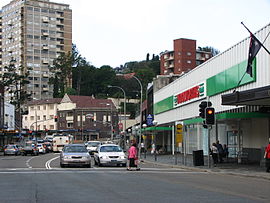
Rose Bay is a harbourside, eastern suburb of Sydney, in the state of New South Wales, Australia. Rose Bay is located seven kilometres east of the Sydney central business district, in the local government areas of Waverley Council and Municipality of Woollahra.
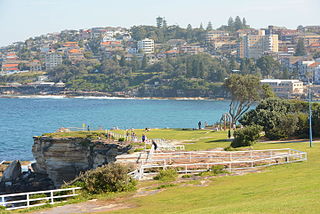
The Eastern Suburbs is the metropolitan region directly to the east and south-east of the central business district in Sydney, New South Wales, Australia.

Bondi Junction railway station is located on the Eastern Suburbs line, serving the Sydney suburb of Bondi Junction. It is served by Sydney Trains T4 Eastern Suburbs & Illawarra Line services and NSW TrainLink South Coast Line services.

The Eastern Suburbs Railway is a commuter railway line in Sydney constructed in the 1970s. It is operated by Sydney Trains and has stations at Martin Place, Kings Cross, Edgecliff and Bondi Junction. In addition, it has dedicated platforms at Town Hall, Central and Redfern stations. All of these stations are underground. The Eastern Suburbs railway connects with the Illawarra line at Erskineville, forming the Eastern Suburbs & Illawarra Line. The line features turnbacks at Central, Martin Place and Bondi Junction. There is also a rarely used cross-over or 'turnout' at Edgecliff. It operates a service every 3 to 5 minutes during weekday peak hours and 8 to 10 minutes at all other times.

Woollahra is a suburb in the Eastern Suburbs of Sydney, in the state of New South Wales, Australia. Woollahra is located 5 kilometres east of the Sydney central business district, in the local government area of the Municipality of Woollahra. Woollahra is located on the traditional land of the Birrabirragal and Gadigal people of the Eora Nation. The Municipality of Woollahra takes its name from the suburb but its administrative centre is located in Double Bay. Woollahra is famous for its quiet, tree-lined residential streets and village-style shopping centre.

Paddington is an inner-city area of Sydney, in the state of New South Wales, Australia. Located 3 kilometres (1.9 mi) east of the Sydney central business district, Paddington lies across two local government areas. The portion south of Oxford Street lies within the City of Sydney, while the portion north of Oxford Street lies within the Municipality of Woollahra. It is often colloquially referred to as "Paddo".

Bellevue Hill is a harbourside eastern suburb of Sydney, in the state of New South Wales, Australia, located 5 kilometres east of the Sydney central business district, in the Municipality of Woollahra.

The Division of Wentworth is an Australian electoral division in the state of New South Wales.

Watsons Bay is a harbourside, eastern suburb of Sydney, in the state of New South Wales, Australia. Watsons Bay is located 11 km north-east of the Sydney central business district, in the local government area of the Municipality of Woollahra.
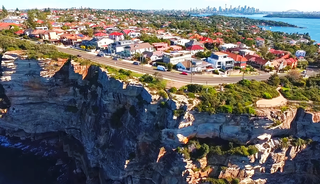
Vaucluse is an eastern suburb of Sydney, in the state of New South Wales, Australia. It is located 8 kilometres (5 mi) north-east of the Sydney central business district, in the local government areas of Waverley Council and the Municipality of Woollahra.

Edgecliff is a small suburb in the Eastern Suburbs of Sydney, in the state of New South Wales, Australia. Edgecliff is located 4 kilometres east of the Sydney central business district, in the local government area of the Municipality of Woollahra. The postcode is 2027.
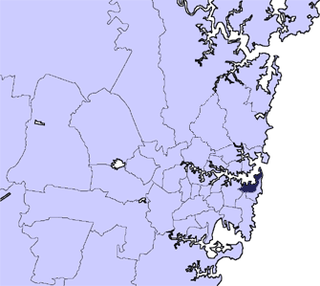
Woollahra Municipal Council is a local government area in the eastern suburbs of Sydney, in the state of New South Wales, Australia. Woollahra is bounded by Sydney Harbour in the north, Waverley Council in the east, Randwick City in the south and the City of Sydney in the west.

Edgecliff railway station is located on the Eastern Suburbs line, serving the Sydney suburb of Edgecliff. It is served by Sydney Trains T4 Eastern Suburbs & Illawarra Line services and NSW TrainLink South Coast Line services.

Darling Point is a harbourside eastern suburb of Sydney, Australia. It is 4 kilometres east of the Sydney central business district and is part of the local government area of Woollahra Council.

The Sydney Stadium was a sporting and entertainment venue in Sydney, New South Wales, which formerly stood on the corner of New South Head Road and Neild Avenue, Rushcutters Bay. Built in 1908, it was demolished in 1970 to make way for the construction of the Eastern Suburbs Railway.

William Street is a 1.4-kilometre-long (0.87 mi) major thoroughfare in Sydney, New South Wales, Australia.

Woollahra railway station was a proposed railway station on Sydney's Eastern Suburbs line. Named after the suburb it was located in, Woollahra railway station would have been built between the present stations of Edgecliff and Bondi Junction. The proposed site of the station currently exists as a cutting off Edgecliff Road. Had this station been completed, it would have been the only above-ground station on the line. Opposition from local residents and costs associated with the construction of the Eastern Suburbs railway prevented the station from being opened.

Old South Head Road is a road in Sydney which goes from the suburb of Bondi Junction to Watsons Bay. It also passes through Bondi, Bondi Beach, North Bondi, Rose Bay and Vaucluse. It is historically significant because its earliest origins can be traced back to the early days of the colony. The road goes through the local government areas of Waverley Council and the Municipality of Woollahra. It is 6.8 kilometres long.

Rose Bay Sea Wall is a heritage-listed former Aboriginal land, farms and road reserve and now sea wall, road reserve and esplanade at New South Head Road, Rose Bay, in the Municipality of Woollahra local government area of New South Wales, Australia. It was designed by Herbert E. Ross and built from 1924 to 1926 by Woollahra Municipal Council. It is also known as Rose Bay Sea Wall, Promenade and its setting. It was added to the New South Wales State Heritage Register on 22 August 2014.
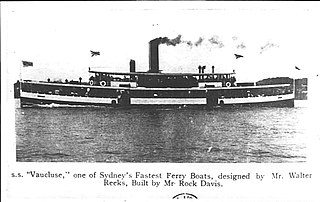
Vaucluse was a ferry on Sydney Harbour that served on the Circular Quay to Watsons Bay run. She was launched in 1905, and was one of the fastest ferries in Sydney. She was sent to Newcastle after which her fate is unknown.
